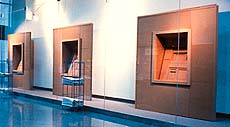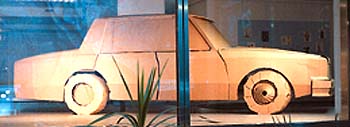| Julia Woodmore - Portfolio > Thesis > James Carl | Home | Contents|  PDF Version PDF Version |
| Julia Woodmore - Portfolio > Thesis > James Carl | Home | Contents|  PDF Version PDF Version |
Within this case study, through my role as 'audience', I will be using the opportunity to take a more objective stance to issues that are raised by James Carl and the way in which he works. This study allows for further investigation into the now seven forms of material association that I had concluded to be of importance at the end of my word association chapter. It lets me continue to explore the issues highlighted through the theory and word association using the context of cardboard to validate my findings.
In the initial stages of my research program part of my criteria was to find another artist who had worked in cardboard so as to give a foundation for my own work. Initially I was some what daunted by this task but I knew that it had been done before and I was pleasantly surprised by the shear volume of artists who at some point in their careers had turned their hand to cardboard.
Having paged through the likes of Japanese architect Shigeru Ban's cardboard and paper buildings and considered 'Unboxed: Sculptures in cardboard'2 I finally chose to concentrate on the work of Canadian Artist James Carl whose career has not only involved sculptures made from cardboard but whose work and 'performance' is often placed in the realm of the public arena (i.e. on the streets) and showcased in a similar way to how many of us approach our explorations and work as public art students holding a particular relevancy to my own work.
 In the 1990's James Carl spent much of his career making 'disposable mass produced items'.[21] In 1993 for a show at Galerie Clark he presented various consumer appliances; refrigerators, stoves, toasters and a television to name but a few. These were all made from cardboard in a 'real-life' scale, questioning the position that art holds in the chain of production/consumption and presenting
In the 1990's James Carl spent much of his career making 'disposable mass produced items'.[21] In 1993 for a show at Galerie Clark he presented various consumer appliances; refrigerators, stoves, toasters and a television to name but a few. These were all made from cardboard in a 'real-life' scale, questioning the position that art holds in the chain of production/consumption and presenting
In the sense that what was once 'formless' it now appears to be an object showing how the association of use of the material is playing a role.
Not just any type of cardboard was used in these constructions - Carl made them from the discarded containers (the packaging) of exactly the products they represented,
Each week during this installation he would place some of these 'appliances' on the streets, as rubbish. Some were picked up by passers by and others were cleared away along with the 'normal' rubbish. By incorporating this element of work into his equation he 'broached questions no longer standard to current artistic practise. Carl's crafted objects are made to appear like consumer items - but they are every bit a ephemeral, changing and short lived as elements in nature and the art world.' [24]
In a similar way to my word association experiment these reactions to Carl's work represent the dichotomy that surrounds cardboard as a material - as something useful (and in this case as an aesthetic piece), but also as something to be discarded - not the product held within the cardboard.
This project was developed in his 'Public works: Cardboard only' show held at the Grunt Gallery in Vancouver, April 1993. Attempting to,
he (re)constructed a full scale 'garbage dumpster', every detail made from cardboard. After the show he again took to the streets placing this work in an alleyway next to a 'real' dumpster, challenging, 'the waste disposal function of the original container by building the same purpose into a material that itself was judged as mere waste.' [26]
Needless to say the work was taken away by a real 'garbage truck.'
A link with personal material association is formed here in the publics reception of this work. It was viewed both as a piece of art but it was equally treated as rubbish. In terms of place association we can see here that this performative aspect of Carl's work, the surroundings and environment, have become the fate of his work. Perhaps the most important issue that arises from this is the media association. At the same time as relying on these associations it refutes them i.e. making the useless useful.
Through this case study it becomes apparent that not all associations are applicable in every case of work. Issues such as basic form as discussed in Andy Goldsworthy's work held no relevency for me here. Quality was also irrelevent here. Carl's work was not based around the way the material felt as work but was instead a statement concerning consumerism. Out of all of the types of material associations the idea of the transformative was the most difficult to apply in this situation because it is so ambiguous. In so much as the cardboard now 'becomes' something the associations shift introducing a whole host of philosophical ideas and theories that I am not exploring in this essay.
This study was useful in the way that it illustrates how art can play with and disrupt the associations that are formed through the work. Whilst this is not a 'ground breaking' fact in its own right, the fact that it can affect a material to this extent and not just be for the use of political comment shows me how important the role of the audience, who generate a new set of associations of their own, is.


| Word Association < James Carl > Conclusion | Home | Contents|  PDF Version PDF Version |